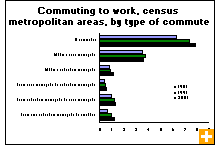Common menu bar links
Commuting: Our changing habits
Archived Content
Information identified as archived is provided for reference, research or recordkeeping purposes. It is not subject to the Government of Canada Web Standards and has not been altered or updated since it was archived. Please contact us to request a format other than those available.
These days, the drive to work often leads to the suburbs instead of to the closest metropolis. With a surge in businesses and housing developments in the suburbs, more workers are travelling to jobs within their own suburban community or commuting to other local suburbs—in some cases, reversing the traditional commute downtown.
From 1981 to 2001, the number of workers travelling to a suburb increased 74% to 1.8 million, while those commuting to a central municipality rose by only 28% to 1.3 million. Of those 1.8 million workers who commuted to the suburbs, about two-thirds came from another local suburb and one-third from the core municipality.
In 2001, more than 13.5 million Canadians commuted to work daily. Three in four Canadians drove to work, and another 1 in 10 used public transportation. The majority of those who took public transport to work were women and younger workers aged 20 to 24. Women are more likely to walk to work, whereas men are more apt than women to ride their bicycles—at a ratio of almost three to one.
 The
median commuting distance (one-way) was 7.2 kilometres in 2001. People
in Oshawa (10.7 kilometres), Toronto (9.2 kilometres) and
Hamilton (8.2 kilometres) travelled the longest distances to
work. One in eight Canadians travelled more than 25 kilometres,
roughly the same proportion as five years prior.
The
median commuting distance (one-way) was 7.2 kilometres in 2001. People
in Oshawa (10.7 kilometres), Toronto (9.2 kilometres) and
Hamilton (8.2 kilometres) travelled the longest distances to
work. One in eight Canadians travelled more than 25 kilometres,
roughly the same proportion as five years prior.
Home offices have emerged as an urban phenomenon. In 2001, close to 1.2 million people reported working at home. Home workers accounted for 6% of all workers in urban areas, double the proportion in 1981.


